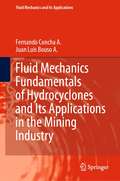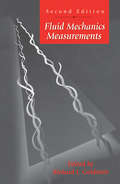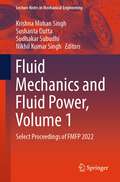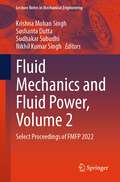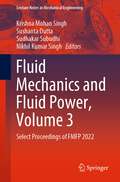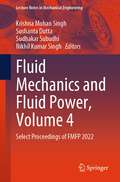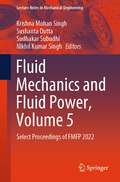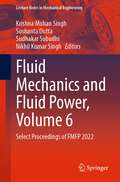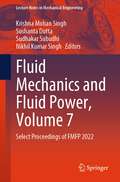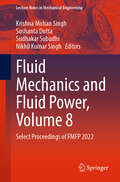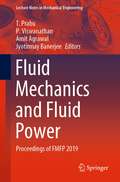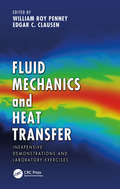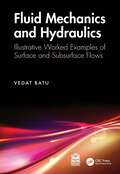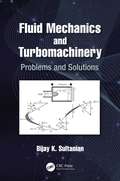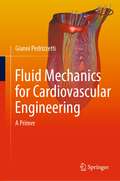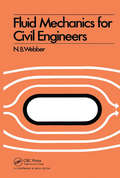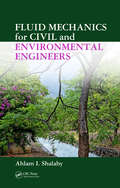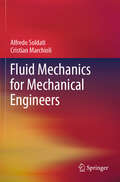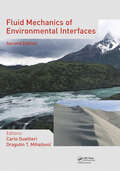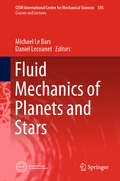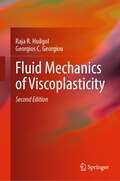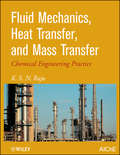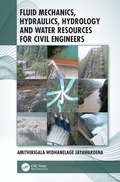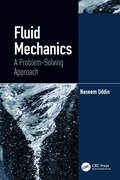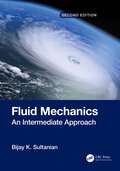- Table View
- List View
Fluid Mechanics Fundamentals of Hydrocyclones and Its Applications in the Mining Industry (Fluid Mechanics and Its Applications #126)
by Fernando Concha A. Juan Luis Bouso A.This book covers topics on engineering science, technology and applications of the classification of particles in liquids suspensions in hydrocyclones. It is divided into 12 chapters starting with the introduction of the hydrocyclone to the mining industry and its several applications of classification, followed by the fundamentals of classification. A special chapter on the fundamentals of sedimentation as the mechanism of the hydrocyclone classification is given. The authors also cover the fundamentals hydrodynamics of solid–fluid interaction with application to the fluids and suspensions flow of in circular pipelines and discusses the flow pattern in hydrocyclones from a fluid dynamics point of view. The physical design, the empirical, phenomenological and numerical hydrocyclone models are presented. The two last chapters deal with the applications of hydrocyclones system design and instrumentation study cases of application in hydrocyclones to the mining industry. Several parts of this book are the result of the work of their research and professional groups from the university and industry.
Fluid Mechanics Measurements
by R. GoldsteinThis revised edition provides updated fluid mechanics measurement techniques as well as a comprehensive review of flow properties required for research, development, and application. Fluid-mechanics measurements in wind tunnel studies, aeroacoustics, and turbulent mixing layers, the theory of fluid mechanics, the application of the laws of fluid mechanics to measurement techniques, techniques of thermal anemometry, laser velocimetry, volume flow measurement techniques, and fluid mechanics measurement in non-Newtonian fluids, and various other techniques are discussed.
Fluid Mechanics and Fluid Power, Volume 1: Select Proceedings of FMFP 2022 (Lecture Notes in Mechanical Engineering)
by Sudhakar Subudhi Krishna Mohan Singh Sushanta Dutta Nikhil Kumar SinghThis book comprises select peer-reviewed proceedings of the 9th International and 49th National Conference on Fluid Mechanics and Fluid Power (FMFP 2022). This book brings together scientific ideas and engineering solutions put forth by researchers and practitioners from academia and industry in the important and ubiquitous field of fluid mechanics. The contents of this book focus on fundamental issues and perspective in fluid mechanics, measurement techniques in fluid mechanics, computational fluid and gas dynamics, instability, transition and turbulence, fluid-structure interaction, multiphase flows, microfluidics, bio-inspired fluid mechanics, aerodynamics, turbomachinery, propulsion and power and other miscellaneous topics in the broad domain of fluid mechanics. This book is a useful reference to researchers and professionals working in the broad field of mechanics.
Fluid Mechanics and Fluid Power, Volume 2: Select Proceedings of FMFP 2022 (Lecture Notes in Mechanical Engineering)
by Sudhakar Subudhi Krishna Mohan Singh Sushanta Dutta Nikhil Kumar SinghThis book comprises select peer-reviewed proceedings of the 9th International and 49th National Conference on Fluid Mechanics and Fluid Power (FMFP 2022). This book brings together scientific ideas and engineering solutions put forth by researchers and practitioners from academia and industry in the important and ubiquitous field of fluid mechanics. The contents of this book focus on fundamental issues and perspective in fluid mechanics, measurement techniques in fluid mechanics, computational fluid and gas dynamics, instability, transition and turbulence, fluid-structure interaction, multiphase flows, microfluidics, bio-inspired fluid mechanics, aerodynamics, turbomachinery, propulsion and power and other miscellaneous topics in the broad domain of fluid mechanics. This book is a useful reference to researchers and professionals working in the broad field of mechanics.
Fluid Mechanics and Fluid Power, Volume 3: Select Proceedings of FMFP 2022 (Lecture Notes in Mechanical Engineering)
by Sudhakar Subudhi Krishna Mohan Singh Sushanta Dutta Nikhil Kumar SinghThis book comprises select peer-reviewed proceedings of the 9th International and 49th National Conference on Fluid Mechanics and Fluid Power (FMFP 2022). This book brings together scientific ideas and engineering solutions put forth by researchers and practitioners from academia and industry in the important and ubiquitous field of fluid mechanics. The contents of this book focus on fundamental issues and perspective in fluid mechanics, measurement techniques in fluid mechanics, computational fluid and gas dynamics, instability, transition and turbulence, fluid-structure interaction, multiphase flows, microfluidics, bio-inspired fluid mechanics, aerodynamics, turbomachinery, propulsion and power and other miscellaneous topics in the broad domain of fluid mechanics. This book is a useful reference to researchers and professionals working in the broad field of mechanics.
Fluid Mechanics and Fluid Power, Volume 4: Select Proceedings of FMFP 2022 (Lecture Notes in Mechanical Engineering)
by Sudhakar Subudhi Krishna Mohan Singh Sushanta Dutta Nikhil Kumar SinghThis book comprises select peer-reviewed proceedings of the 9th International and 49th National Conference on Fluid Mechanics and Fluid Power (FMFP 2022). This book brings together scientific ideas and engineering solutions put forth by researchers and practitioners from academia and industry in the important and ubiquitous field of fluid mechanics. The contents of this book focus on fundamental issues and perspective in fluid mechanics, measurement techniques in fluid mechanics, computational fluid and gas dynamics, instability, transition and turbulence, fluid-structure interaction, multiphase flows, microfluidics, bio-inspired fluid mechanics, aerodynamics, turbomachinery, propulsion and power and other miscellaneous topics in the broad domain of fluid mechanics. This book is a useful reference to researchers and professionals working in the broad field of mechanics.
Fluid Mechanics and Fluid Power, Volume 5: Select Proceedings of FMFP 2022 (Lecture Notes in Mechanical Engineering)
by Sudhakar Subudhi Krishna Mohan Singh Sushanta Dutta Nikhil Kumar SinghThis book comprises select peer-reviewed proceedings of the 9th International and 49th National Conference on Fluid Mechanics and Fluid Power (FMFP 2022). This book brings together scientific ideas and engineering solutions put forth by researchers and practitioners from academia and industry in the important and ubiquitous field of fluid mechanics. The contents of this book focus on fundamental issues and perspective in fluid mechanics, measurement techniques in fluid mechanics, computational fluid and gas dynamics, instability, transition and turbulence, fluid-structure interaction, multiphase flows, microfluidics, bio-inspired fluid mechanics, aerodynamics, turbomachinery, propulsion and power and other miscellaneous topics in the broad domain of fluid mechanics. This book is a useful reference to researchers and professionals working in the broad field of mechanics.
Fluid Mechanics and Fluid Power, Volume 6: Select Proceedings of FMFP 2022 (Lecture Notes in Mechanical Engineering)
by Sudhakar Subudhi Krishna Mohan Singh Sushanta Dutta Nikhil Kumar SinghThis book comprises select peer-reviewed proceedings of the 9th International and 49th National Conference on Fluid Mechanics and Fluid Power (FMFP 2022). This book brings together scientific ideas and engineering solutions put forth by researchers and practitioners from academia and industry in the important and ubiquitous field of fluid mechanics. The contents of this book focus on fundamental issues and perspective in fluid mechanics, measurement techniques in fluid mechanics, computational fluid and gas dynamics, instability, transition and turbulence, fluid-structure interaction, multiphase flows, microfluidics, bio-inspired fluid mechanics, aerodynamics, turbomachinery, propulsion and power and other miscellaneous topics in the broad domain of fluid mechanics. This book is a useful reference to researchers and professionals working in the broad field of mechanics.
Fluid Mechanics and Fluid Power, Volume 7: Select Proceedings of FMFP 2022 (Lecture Notes in Mechanical Engineering)
by Sudhakar Subudhi Krishna Mohan Singh Sushanta Dutta Nikhil Kumar SinghThis book comprises select peer-reviewed proceedings of the 9th International and 49th National Conference on Fluid Mechanics and Fluid Power (FMFP 2022). This book brings together scientific ideas and engineering solutions put forth by researchers and practitioners from academia and industry in the important and ubiquitous field of fluid mechanics. The contents of this book focus on fundamental issues and perspective in fluid mechanics, measurement techniques in fluid mechanics, computational fluid and gas dynamics, instability, transition and turbulence, fluid-structure interaction, multiphase flows, microfluidics, bio-inspired fluid mechanics, aerodynamics, turbomachinery, propulsion and power and other miscellaneous topics in the broad domain of fluid mechanics. This book is a useful reference to researchers and professionals working in the broad field of mechanics.
Fluid Mechanics and Fluid Power, Volume 8: Select Proceedings of FMFP 2022 (Lecture Notes in Mechanical Engineering)
by Sudhakar Subudhi Krishna Mohan Singh Sushanta Dutta Nikhil Kumar SinghThis book comprises select peer-reviewed proceedings of the 9th International and 49th National Conference on Fluid Mechanics and Fluid Power (FMFP 2022). This book brings together scientific ideas and engineering solutions put forth by researchers and practitioners from academia and industry in the important and ubiquitous field of fluid mechanics. The contents of this book focus on fundamental issues and perspective in fluid mechanics, measurement techniques in fluid mechanics, computational fluid and gas dynamics, instability, transition and turbulence, fluid-structure interaction, multiphase flows, microfluidics, bio-inspired fluid mechanics, aerodynamics, turbomachinery, propulsion and power and other miscellaneous topics in the broad domain of fluid mechanics. This book is a useful reference to researchers and professionals working in the broad field of mechanics.
Fluid Mechanics and Fluid Power: Proceedings of FMFP 2019 (Lecture Notes in Mechanical Engineering)
by Amit Agrawal T. Prabu P. Viswanathan Jyotirmay BanerjeeThis book comprises select proceedings of the 46th National Conference on Fluid Mechanics and Fluid Power (FMFP 2019). The contents of this book focus on aerodynamics and flow control, computational fluid dynamics, fluid structure interaction, noise and aero-acoustics, unsteady and pulsating flows, vortex dynamics, nuclear thermal hydraulics, heat transfer in nanofluids, etc. This book serves as a useful reference beneficial to researchers, academicians and students interested in the broad field of mechanics.^
Fluid Mechanics and Heat Transfer: Inexpensive Demonstrations and Laboratory Exercises
by William Roy Penney and Edgar C. ClausenThis practical book provides instruction on how to conduct several "hands-on" experiments for laboratory demonstration in the teaching of heat transfer and fluid dynamics. It is an ideal resource for chemical engineering, mechanical engineering, and engineering technology professors and instructors starting a new laboratory or in need of cost-effective and easy to replicate demonstrations. The book details the equipment required to perform each experiment (much of which is made up of materials readily available is most laboratories), along with the required experimental protocol and safety precautions. Background theory is presented for each experiment, as well as sample data collected by students, and a complete analysis and treatment of the data using correlations from the literature.
Fluid Mechanics and Hydraulics: Illustrative Worked Examples of Surface and Subsurface Flows
by Vedat BatuFluid Mechanics and Hydraulics: Illustrative Worked Examples of Surface and Subsurface Flows presents the basic principles of fluid mechanics through the use of numerous worked examples. Some readers may have interest only in the application parts of various principles without paying too much attention to the derivation details of equations. Other readers may have interest both in derivation details and their applications. As a result, this book is designed to address both needs, and most derivation details are included as example problems. Therefore, those who are not interested in the details of derivations may skip them without interrupting the effective use of the book. It serves as an effective learning source for college students and as a teaching tool for instructors (with an included solutions manual), as well as for practicing professionals in the areas of fluid mechanics and hydraulics.
Fluid Mechanics and Turbomachinery: Problems and Solutions
by Bijay K SultanianReflecting the author’s years of industry and teaching experience, Fluid Mechanics and Turbomachinery features many innovative problems and their systematically worked solutions. To understand fundamental concepts and various conservation laws of fluid mechanics is one thing, but applying them to solve practical problems is another challenge. The book covers various topics in fluid mechanics, turbomachinery flowpath design, and internal cooling and sealing flows around rotors and stators of gas turbines. As an ideal source of numerous practice problems with detailed solutions, the book will be helpful to senior-undergraduate and graduate students, teaching faculty, and researchers engaged in many branches of fluid mechanics. It will also help practicing thermal and fluid design engineers maintain and reinforce their problem-solving skills, including primary validation of their physics-based design tools.
Fluid Mechanics for Cardiovascular Engineering: A Primer
by Gianni PedrizzettiThis book provides a guiding thread between the distant fields of fluid mechanics and clinical cardiology. Well rooted in the science of fluid dynamics, it drives the reader across progressively more realistic scenarios up to the complexity of routine medical applications. Based on the author’s 25 years of collaborations with cardiologists, it helps engineers learn communicating with clinicians, yet maintaining the rigor of scientific disciplines. This book starts with a description of the fundamental elements of fluid dynamics in large blood vessels. This is achieved by introducing a rigorous physical background accompanied by examples applied to the circulation, and by presenting classic and recent results related to the application of fluid dynamics to the cardiovascular physiology. It then explores more advanced topics for a physics-based understanding of phenomena effectively encountered in clinical cardiology. It stands as an ideal learning resource for physicists and engineers working in cardiovascular fluid dynamics, industry engineers working on biomedical/cardiovascular technology, and students in bio-fluid dynamics. Written with a concise style, this textbook is accessible to a broad readership, including students, physical scientists and engineers, offering an entry point into this multi-disciplinary field. It includes key concepts exemplified by illustrations using cutting-edge imaging, references to modelling and measurement technologies, and includes unique original insights.
Fluid Mechanics for Civil Engineers: SI edition
by N.B. WebberThis well-established text book fills the gap between the general texts on fluid mechanics and the highly specialised volumes on hydraulic engineering.It covers all aspects of hydraulic science normally dealt with in a civil engineering degree course and will be as useful to the engineer in practice as it is to the student and the teacher.
Fluid Mechanics for Civil and Environmental Engineers
by Ahlam I. ShalabyAn ideal textbook for civil and environmental, mechanical, and chemical engineers taking the required Introduction to Fluid Mechanics course, Fluid Mechanics for Civil and Environmental Engineers offers clear guidance and builds a firm real-world foundation using practical examples and problem sets. Each chapter begins with a statement of objectives, and includes practical examples to relate the theory to real-world engineering design challenges. The author places special emphasis on topics that are included in the Fundamentals of Engineering exam, and make the book more accessible by highlighting keywords and important concepts, including Mathcad algorithms, and providing chapter summaries of important concepts and equations.
Fluid Mechanics for Mechanical Engineers
by Cristian Marchioli Alfredo SoldatiThis textbook describes the fundamentals of the phenomena of fluid dynamics in the context of engineering instances. It is designed to replace introductory books and notes on the subject for first-level engineering courses as well as higher-level courses or for professional use. The use of this book requires the basic knowledge of mathematics and physics normally delivered in the early years of undergraduate study. However, the extensive use of examples and solved exercises proposes a parallel intuitive route to understanding the necessary mathematical formalisms. It proves that a new fluid dynamics text should not contain new ideas or formalisms, but should present the material in a modern and intuitive way. The approach chosen is primarily practical, so that that readers can practice by solving the proposed problems and examples in order to be prepared to solve the new problems they will encounter in their academic and professional activities. It serves as a teaching tool for coursesin basic fluid dynamics, advanced fluid dynamics, turbulence, and aerodynamics.
Fluid Mechanics of Environmental Interfaces
by Sajjan G. ShivaEnvironmental Fluid Mechanics (EFM) studies the motion of air and water at several different scales, the fate and transport of species carried along by these fluids, and the interactions among those flows and geological, biological, and engineered systems. EFM emerged some decades ago as a response to the need for tools to study problems of flow an
Fluid Mechanics of Planets and Stars (CISM International Centre for Mechanical Sciences #595)
by Michael Le Bars Daniel LecoanetThis book explores the dynamics of planetary and stellar fluid layers, including atmospheres, oceans, iron cores, and convective and radiative zones in stars, describing the different theoretical, computational and experimental methods used to study these problems in fluid mechanics, including the advantages and limitations of each method for different problems. This scientific domain is by nature interdisciplinary and multi-method, but while much effort has been devoted to solving open questions within the various fields of mechanics, applied mathematics, physics, earth sciences and astrophysics, and while much progress has been made within each domain using theoretical, numerical and experimental approaches, cross-fertilizations have remained marginal. Going beyond the state of the art, the book provides readers with a global introduction and an up-to-date overview of relevant studies, fully addressing the wide range of disciplines and methods involved. The content builds on the CISM course “Fluid mechanics of planets and stars”, held in April 2018, which was part of the research project FLUDYCO, supported by the European Research Council (ERC) under the European Union's Horizon 2020 research and innovation program.
Fluid Mechanics of Viscoplasticity
by Raja R. Huilgol Georgios C. GeorgiouThis book considers the kinematics and dynamics of the flows of fluids exhibiting a yield stress. Continuum mechanics governing the fluid mechanics is described. Two chapters are dedicated to analytical solutions to several steady and unsteady flows of viscoplastic fluids, including flows with pressure-dependent rheological parameters. Perturbation methods, variational inequalities to solve fluid flow problems, and the use of energy methods are discussed. Numerical modeling using augmented Lagrangian, operator splitting, finite difference, and lattice Boltzmann methods are employed.The second edition provides new sections on flows of yield stress fluids with pressure-dependent rheological parameters, on flows with wall slip, and on deriving the fundamental equations for Boltzmann lattice materials. Furthermore new material on the lubrication approximation and applications of finite differences has been added.
Fluid Mechanics, Heat Transfer, and Mass Transfer: Chemical Engineering Practice
by K. S. RajuThis broad-based book covers the three major areas of Chemical Engineering. Most of the books in the market involve one of the individual areas, namely, Fluid Mechanics, Heat Transfer or Mass Transfer, rather than all the three. This book presents this material in a single source. This avoids the user having to refer to a number of books to obtain information. Most published books covering all the three areas in a single source emphasize theory rather than practical issues. This book is written with emphasis on practice with brief theoretical concepts in the form of questions and answers, not adopting stereo-typed question-answer approach practiced in certain books in the market, bridging the two areas of theory and practice with respect to the core areas of chemical engineering. Most parts of the book are easily understandable by those who are not experts in the field. Fluid Mechanics chapters include basics on non-Newtonian systems which, for instance find importance in polymer and food processing, flow through piping, flow measurement, pumps, mixing technology and fluidization and two phase flow. For example it covers types of pumps and valves, membranes and areas of their use, different equipment commonly used in chemical industry and their merits and drawbacks. Heat Transfer chapters cover the basics involved in conduction, convection and radiation, with emphasis on insulation, heat exchangers, evaporators, condensers, reboilers and fired heaters. Design methods, performance, operational issues and maintenance problems are highlighted. Topics such as heat pipes, heat pumps, heat tracing, steam traps, refrigeration, cooling of electronic devices, NOx control find place in the book. Mass transfer chapters cover basics such as diffusion, theories, analogies, mass transfer coefficients and mass transfer with chemical reaction, equipment such as tray and packed columns, column internals including structural packings, design, operational and installation issues, drums and separators are discussed in good detail. Absorption, distillation, extraction and leaching with applications and design methods, including emerging practices involving Divided Wall and Petluk column arrangements, multicomponent separations, supercritical solvent extraction find place in the book.
Fluid Mechanics, Hydraulics, Hydrology and Water Resources for Civil Engineers
by Amithirigala Widhanelage JayawardenaOne of the core areas of study in civil engineering concerns water that encompasses fluid mechanics, hydraulics and hydrology. Fluid mechanics provide the mathematical and scientific basis for hydraulics and hydrology that also have added empirical and practical contents. The knowledge contained in these three subjects is necessary for the optimal and equitable management of this precious resource that is not always available when and where it is needed, sometimes with conflicting demands. The objective of Fluid Mechanics, Hydraulics, Hydrology and Water Resources for Civil Engineers is to assimilate these core study areas into a single source of knowledge. The contents highlight the theory and applications supplemented with worked examples and also include comprehensive references for follow-up studies. The primary readership is civil engineering students who would normally go through these core subject areas sequentially spread over the duration of their studies. It is also a reference for practicing civil engineers in the water sector to refresh and update their skills.
Fluid Mechanics: A Problem-Solving Approach
by Naseem UddinFluid Mechanics: A Problem-Solving Approach provides a clear distinction between integral formulation and the different formulation of conservation law. Including a detailed discussion on pipe flow correlations, entrance length correlations, and plotting of Moody diagram, the book works through the comprehensive coverage of fluid mechanics with a gradual introduction of theory in a straightforward, practical approach. The book includes numerous end-of-chapter problems to enhance student understanding and different solving approaches. It features chapters on nanofluids, jets, waves in ocean and rivers, boundary layer separation, and Thwaites integral method, which are not typically covered in an introductory course. Features Provides a comprehensive treatment of fluid mechanics from the basic concepts to in-depth application problems. Covers waves and tsunamis. Offers two distinct chapters on jet flows and turbulent flows. Includes numerous end-of-chapter problems. Includes a Solutions Manual and MAPLE worksheets for instructor use. The book is intended for senior undergraduate mechanical and civil engineering students taking courses in fluid mechanics. The eBook+ version includes the following enhancements: 3 videos placed throughout the text to help apply real-world examples to concepts of Newtonian vs. Non-Newtonian fluids, vortices, and additional information on surface tension. Pop-up explanations of selected concepts as interactive flashcards in each chapter. Quizzes within chapters to help readers refresh their knowledge.
Fluid Mechanics: An Intermediate Approach
by Bijay K. SultanianFluid Mechanics: An Intermediate Approach helps readers develop a physics-based understanding of complex flows and mathematically model them with accurate boundary conditions for numerical predictions.The new edition starts with a chapter reviewing key undergraduate concepts in fluid mechanics and thermodynamics, introducing the generalized conservation equation for differential and integral analyses. It concludes with a self-study chapter on computational fluid dynamics (CFD) of turbulent flows, including physics-based postprocessing of 3D CFD results and entropy map generation for accurate interpretation and design applications. This book includes numerous worked examples and end-of-chapter problems for student practice. It also discusses how to numerically model compressible flow over all Mach numbers in a variable-area duct, accounting for friction, heat transfer, rotation, internal choking, and normal shock formation.This book is intended for graduate mechanical and aerospace engineering students taking courses in fluid mechanics and gas dynamics.Instructors will be able to utilize a solutions manual for their course.
